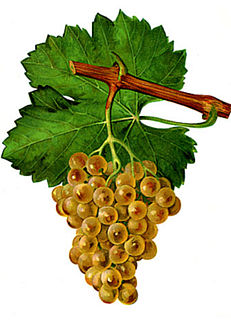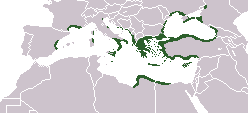Related Research Articles

Wine is an alcoholic drink typically made from fermented grape juice. Yeast consumes the sugar in the grapes and converts it to ethanol, carbon dioxide, and heat. Different varieties of grapes and strains of yeasts produce different styles of wine. These variations result from the complex interactions between the biochemical development of the grape, the reactions involved in fermentation, the grape's growing environment (terroir), and the production process. Many countries enact legal appellations intended to define styles and qualities of wine. These typically restrict the geographical origin and permitted varieties of grapes, as well as other aspects of wine production. Wines not made from grapes involve fermentation of additional crops, including rice wine and other fruit wines such as plum, cherry, pomegranate, currant and elderberry.

Viticulture or winegrowing is the cultivation and harvesting of grapes. It is a branch of the science of horticulture. While the native territory of Vitis vinifera, the common grape vine, ranges from Western Europe to the Persian shores of the Caspian Sea, the vine has demonstrated high levels of adaptability to new environments, hence viticulture can be found on every continent except Antarctica.

Sangiovese is a red Italian wine grape variety that derives its name from the Latin sanguis Jovis, "the blood of Jupiter". Though it is the grape of most of central Italy from Romagna down to Lazio, Campania and Sicily, outside Italy it is most famous as the only component of Brunello di Montalcino and Rosso di Montalcino and the main component of the blends Chianti, Carmignano, Vino Nobile di Montepulciano and Morellino di Scansano, although it can also be used to make varietal wines such as Sangiovese di Romagna and the modern "Super Tuscan" wines like Tignanello.

Château d'Yquem is a Premier Cru Supérieur wine from the Sauternes, Gironde region in the southern part of the Bordeaux vineyards known as Graves. In the Bordeaux Wine Official Classification of 1855, Château d'Yquem was the only Sauternes given this rating, indicating its perceived superiority and higher prices over all other wines of its type. Yquem's success stems largely from the site's susceptibility to attack by "noble rot".

Sémillon is a golden-skinned grape used to make dry and sweet white wines, mostly in France and Australia. Its thin skin and susceptibility to botrytis make it dominate the sweet wine region Sauternes AOC and Barsac AOC.

Aglianico is a black grape grown in the southern regions of Italy, mostly Basilicata and Campania. It is considered with Sangiovese and Nebbiolo to be one of the three greatest Italian varieties. Aglianico is sometimes called "The Barolo of the South" due to its ability to produce highly refined, complex fine wines like the famous Piedmont wine, Barolo.
Falernian wine was produced from Aglianico grapes on the slopes of Mount Falernus near the border of Latium and Campania, where it became the most renowned wine produced in ancient Rome; Silius Italicus attributed its origin to a mythic figure named Falernus, who lived in the late 3rd century BC. Considered a "first growth" or "cult wine" for its time, it was often mentioned in Roman literature, but has since disappeared. There were three vineyards recognized by Romans: Caucinian Falernian from the vineyards on the highest slopes of Mount Falernus; Faustian Falernian, the most famous, from land on the central slopes corresponding to the current hilly areas of the town of Falciano del Massico and Carinola di Casanova, owned by Faustus, son of the Roman dictator Sulla; and wine from the lower slopes and plain that was simply called Falernian. The area is now occupied by the modern day vineyards of Rocca di Mondragone and Monte Massico.
Alban wine is a notable wine of Ancient Rome that was grown in the Colli Albani region, 20 kilometres (12 mi) Southeast of Rome, at the foot of Mt. Albus. The area is now occupied by the modern day papal residence of Castelgandolfo. The land was praised by Columella "For there is no doubt that, of all the vines that the earth sustains, those of the Massic, Surrentine, Alban, and Caecuban lands hold first place in the excellence of their wine".
A fumarium was a smoke chamber used in Ancient Rome to enhance the flavor of wine through artificially "aging" the wine. Amphorae were placed in the chamber, which was built on top of a heated hearth, in order to impart a smoky flavor in the wine that also seemed to sharpen the acidity. The wine would sometimes come out of the fumarium with a paler color. In his book Vintage: The Story of Wine, Hugh Johnson noted that Pliny the Elder and Columella did not recommend that "first-growth wines" like Falernian, Caecuban, and Alban be smoked.

The Gardens of Maecenas, built by Gaius Maecenas, an Augustan-era patron of the arts, were the first gardens in the Hellenistic-Persian garden style in Rome. He sited them on the Esquiline Hill, atop the agger of the Servian Wall and its adjoining necropolis, near the gardens of Lamia.
Raboso is a red wine grape grown primarily in the eastern part of Veneto. It is also called Raboso Piave, from the name of a river near where it is grown. It produces deep-colored wine, with notably high levels of tannin and medium alcohol content and high acid. The name raboxo in the native Venetian language means "angry", because angry is the sensation in the mouth when this wine is drunk young. Raboso was in the past the most cultivated grape variety of eastern Veneto; Venetian navigators called it vin de viajo, "wine of travel", because it was the most resistant to aging and transport. Its popularity decreased in the 20th century, and today the vineyards of Raboxo are just 1–2% of the total amount of vineyards in Veneto.

Wine has been produced for thousands of years, with evidence of ancient wine production in Georgia (c. 8000 China, Armenia ,Georgia[10] from 6000 BC, Iran from 5000 BC, and Sicily from 4000 BC.

Vincotto is a dark, sweet, thick paste produced by in rural areas of Italy. It is made by the slow cooking and reduction over many hours of non-fermented grape must until it has been reduced to about one-fifth of its original volume and the sugars present have caramelized. It can be made from a number of varieties of local red wine grapes, including Primitivo, Negroamaro and Malvasia Nera, and before the grapes are picked they are allowed to wither naturally on the vine for about thirty days. In Roman times it was known as sapa in Latin and epsima in Greek, the same names that are often used for it in Italy and Cyprus, respectively, today.
Greco is an Italian wine grape that may be of Greek origin. The name relates to both white (Greco bianco) and black (Greco nero) grape varieties. While there is more land area dedicated to Greco nero, the Greco bianco is the grape most commonly referred to by "Greco". In the Campania region it is used to produce the Denominazione di Origine Controllata e Garantita (DOCG) wine Greco di Tufo. In Calabria, it is used to make the Denominazione di Origine Controllata (DOC) wine Greco di Bianco. The name "Greco" is sometimes used as a synonym for several varieties of supposed Greek origins-most notably Trebbiano.

The influence of wine in ancient Greece helped ancient Greece trade with neighboring countries and regions. Many mannerisms and cultural aspects were associated with wine. It led to great change in Ancient Greece as well.
The peoples of the Mediterranean began to emerge from barbarism when they learned to cultivate the olive and the vine.

Ancient Rome played a pivotal role in the history of wine. The earliest influences on the viticulture of the Italian peninsula can be traced to ancient Greeks and the Etruscans. The rise of the Roman Empire saw both technological advances in and burgeoning awareness of winemaking, which spread to all parts of the empire. Rome's influence has had a profound effect on the histories of today's major winemaking regions in France, Germany, Italy, Portugal and Spain.

The Vinalia were Roman festivals of the wine harvest, wine vintage and gardens, held in honour of Jupiter and Venus. The Vinalia prima, also known as the Vinalia urbana was held on 23 April to bless and sample last year's wine and ask for good weather until the next harvest. The Vinalia rustica was on 19 August, before the harvest and grape-pressing.

Mastroberardino is an Italian winery located in Atripalda, in Provincia di Avellino, in the Campania region. Founded in 1878, the winery is known for its production of Taurasi DOCG as well as its ampelography work in identifying and preserving ancient grape varieties like Greco and Fiano. The work of the Mastroberardino family, particularly Antonio Mastroberardino, in this field is widely respected and Antonio is often called "The Grape Archaeologist".
Abbuoto is a red Italian wine grape variety that is grown primarily in the Lazio region of central Italy. Historically the grape was believed to be responsible for the Ancient Roman wine Caecubum that was praised by writers such as Pliny the Elder and Horace but historians and wine experts such as Jancis Robinson and Julia Harding note that connection is likely erroneous.

Grape syrup is a condiment made with concentrated grape juice. It is thick and sweet because of its high ratio of sugar to water. Grape syrup is made by boiling grapes, removing their skins, squeezing them through a sieve to extract the juice, and adding sugar. Like other fruit syrups, a common use of grape syrup is as a topping to sweet cakes, such as pancakes or waffles.
References
- ↑ Roman Vintages
- ↑ Odes 1.20
- ↑ "Horace: Some Odes in English Translation". Archived from the original on 2006-07-25. Retrieved 2006-06-19.
- ↑ The Works of Horace - The Book of the Epodes of Horace. (by Horace)
- ↑ Roman Wine
- ↑ Hugh Johnson, Vintage: The Story of Wine p. 62. Simon and Schuster 1989.
- ↑ J. Robinson, J. Harding and J. Vouillamoz Wine Grapes - A complete guide to 1,368 vine varieties, including their origins and flavours pg 3, Allen Lane 2012 ISBN 978-1-846-14446-2